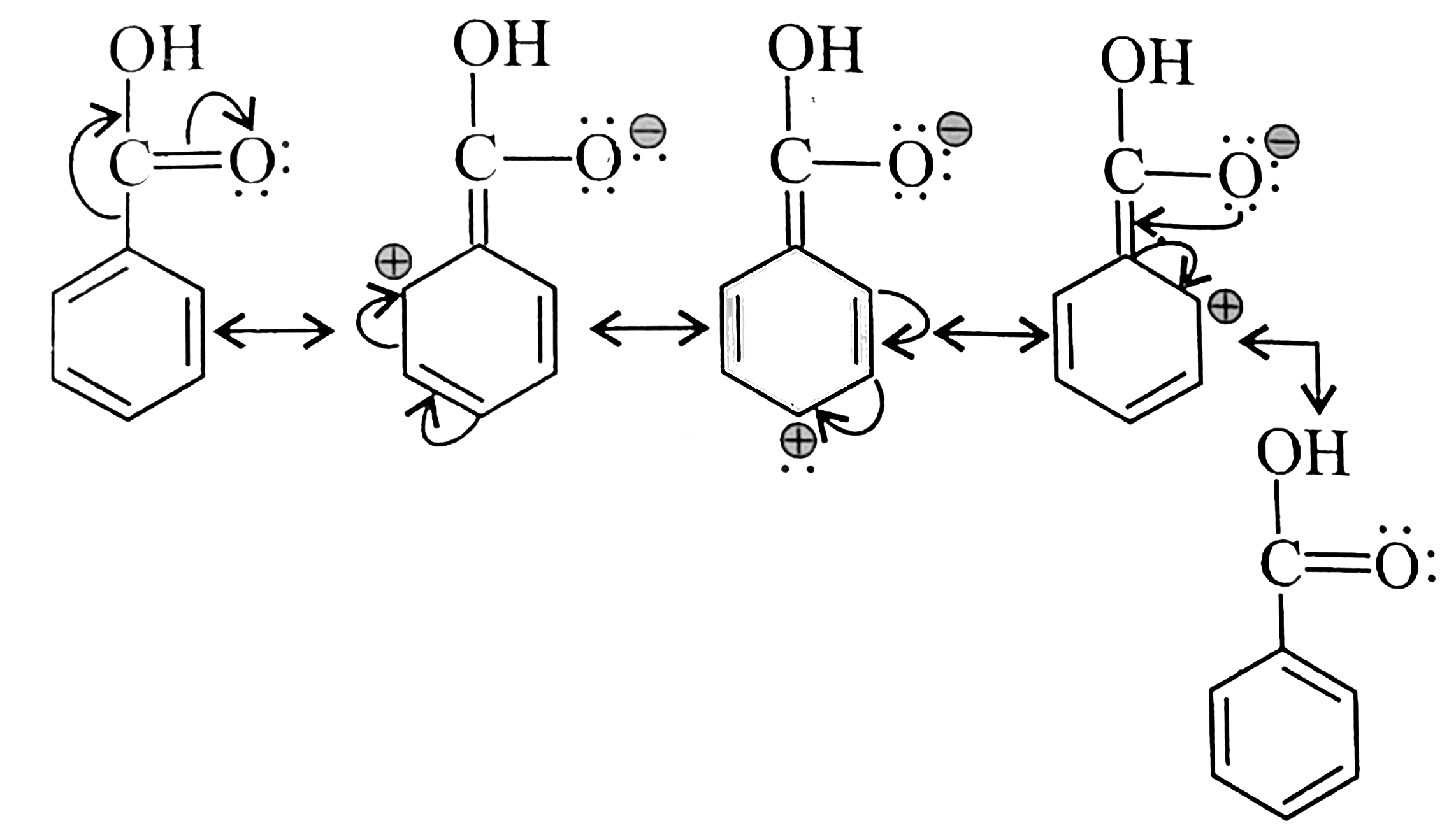a. Why are ¯e donating groups, such as (−NH2) (−OR), (−R)o− and p− directing towards SE reaction? Explain by an example.
b. Why are ¯e withdrawing groups, [such as (−NO2,(−SO3H),(−CN),(−COOH), etc].m− direection towards SE reaction? explain by example.
c. Although halogens are ¯e withdrawing yet they are o− and p− directing towards SE reaction. Why?
a. Due to +M effect (or ovel∈e(e) donating effect) of (−NH2) group, aniline is resonance stablised as shown:

Due to this, the ring is activated at o− and p− positions. Thus, ¯e density is increased at these positions. Hence, the incoming electrophile attacks at these positions giving o− and p− products. b. Due to ¯¯¯¯¯¯¯e− withdrawing effect of the (−COOH) group, benozoic acid is resonance stablised as shown:

due to this, the benzene ring is deactived at o− and p− positons, thus ¯e density is decreased at these positon. So, comparatively ¯e density at m− position is increased, and hence the incoming electrophile attacks at m-postion giving m− products,
C. Halogens are said to be π donating but σ with-drawing, i.e., they withdraw ¯es thorugh resonance. The intermediate carbocation formed during SE reaction is destablised by the −1 effect of the halogens.

Resonane stablises the intermediate carbocation and this effect is more prominent at o− and p− positons, −I effect is stronger (due to high EN of halogens ) than resonance and causes net ¯e withdrawal, and thus causing net deactivation. The resonance effect for the attack at o− and p− positons and hence makes the deactivation lesss for o− and p− subsitution.
Topper's Solved these Questions
- AROMATIC COMPOUNDS AND ALKYL AND ARYL HALIDES BOOK - CENGAGE CHEMISTRYCHAPTER - AROMATIC COMPOUNDS AND ALKYL AND ARYL HALIDES EXERCISE - Solved Examples
21 Videos
- AROMATIC COMPOUNDS AND ALKYL AND ARYL HALIDES BOOK - CENGAGE CHEMISTRYCHAPTER - AROMATIC COMPOUNDS AND ALKYL AND ARYL HALIDES EXERCISE - Solved Problems
37 Videos
- APPENDIX INORGANIC VOLUME 2BOOK - CENGAGE CHEMISTRYCHAPTER - APPENDIX INORGANIC VOLUME 2EXERCISE - Short Answer Type
179 Videos
- BIOMOLECULESBOOK - CENGAGE CHEMISTRYCHAPTER - BIOMOLECULESEXERCISE - Exercises Archives (Analytical And Descriptive)
8 Videos
Similar Questions
Explain why the amino group in aniline acts as a powerful activator and o- and p- director towards electrophilic substitution reaction.
View SolutionAlthough chlorine is an electron withdrawing group, yet it is ortho-, para- directing in electrophilic aromatic substitution reactions. Why?
View Solution
Knowledge Check
The typical reaction of benzene and other aromatic compounds are electrophilic substitution. Presence of electron donating group activates the ring towards electrophilic substitution, while presence of electron withdrawing group deactivates the ring towards electrophilic substituion but at the same time activates the ring towards nucleophilic subsituion. Some groups are predominantly meta-directing and all of these are deactivating. Except halogen, most of the o−andp−directing groups are activating groups.
_E01_246_Q01.png) C2H5Cl.AlCl3−−−−−−−−→Δ(A) major.
C2H5Cl.AlCl3−−−−−−−−→Δ(A) major.
A is trisubstituted benzene. The structure of A is :A_E01_246_O01.png) B
B_E01_246_O02.png) C
C_E01_246_O03.png) D
D_E01_246_O04.png)
The typical reaction of benzene and other aromatic compounds are electrophilic substitution. Presence of electron donating group activates the ring towards electrophilic substitution, while presence of electron withdrawing group deactivates the ring towards electrophilic substituion but at the same time activates the ring towards nucleophilic subsituion. Some groups are predominantly meta-directing and all of these are deactivating. Except halogen, most of the o−andp−directing groups are activating groups.
Which of the following compound is not formed.
_E01_248_Q01.png) (i)NBS,CCl4,hv−−−−−−−−−−−→(II)Br2/FeBr3(X)
(i)NBS,CCl4,hv−−−−−−−−−−−→(II)Br2/FeBr3(X)
X represents mixture of organic compounds. The mixture does not containA_E01_248_O01.png) B
B_E01_248_O02.png) C
C_E01_248_O03.png) Dall of them
Dall of them
Althrough chlorine is an electron withdrawing group, yet it is ortho-para-directing in electrophilic aromatic substitution reactions. Explain why it is so ?
View Solution(a). Why are alkyl halides insoluble in water?
(b). Why is butan-1-ol optically inactive but butane-2 ol is optically active in nature?
(c). Although chlorine is an electron withdrawing group yet it is ortho para directing in electrophilic aromatic substitution reaction. Why?
View SolutionThe typical reaction of benzene and other aromatic compounds are electrophilic substitution. Presence of electron donating group activates the ring towards electrophilic substitution, while presence of electron withdrawing group deactivates the ring towards electrophilic substituion but at the same time activates the ring towards nucleophilic subsituion. Some groups are predominantly meta-directing and all of these are deactivating. Except halogen, most of the o−andp−directing groups are activating groups.
Which of the following compound is not formed.
_E01_248_Q01.png)
X represents mixture of organic compounds. The mixture does not contain
View Solution(a) Why are alkyl halides insoluble in water ?
(b) Why is Butan-1- ol optically inactive but Butan-2-ol is optically actove ?
(c ) Although chlorine is an electron-withdrawing group, yet it is ortho-para-directing in electrophilic aromatic substitution reactions. Why?
View SolutionThe typical reaction of benzene and other aromatic compounds are electrophilic substitution. Presence of electron donating group activates the ring towards electrophilic substitution, while presence of electron withdrawing group deactivates the ring towards electrophilic substituion but at the same time activates the ring towards nucleophilic subsituion. Some groups are predominantly meta-directing and all of these are deactivating. Except halogen, most of the o−andp−directing groups are activating groups.
_E01_246_Q01.png) C2H5Cl.AlCl3−−−−−−−−→Δ(A) major.
C2H5Cl.AlCl3−−−−−−−−→Δ(A) major.
A is trisubstituted benzene. The structure of A is :
View SolutionThe typical reaction of benzene and other aromatic compounds are electrophilic substitution. Presence of electron donating group activates the ring towards electrophilic substitution, while presence of electron withdrawing group deactivates the ring towards electrophilic substituion but at the same time activates the ring towards nucleophilic subsituion. Some groups are predominantly meta-directing and all of these are deactivating. Except halogen, most of the o−andp−directing groups are activating groups.
_E01_246_Q01.png) C2H5Cl.AlCl3−−−−−−−−→Δ(A) major.
C2H5Cl.AlCl3−−−−−−−−→Δ(A) major.
A is trisubstituted benzene. The structure of A is :
View Solution
